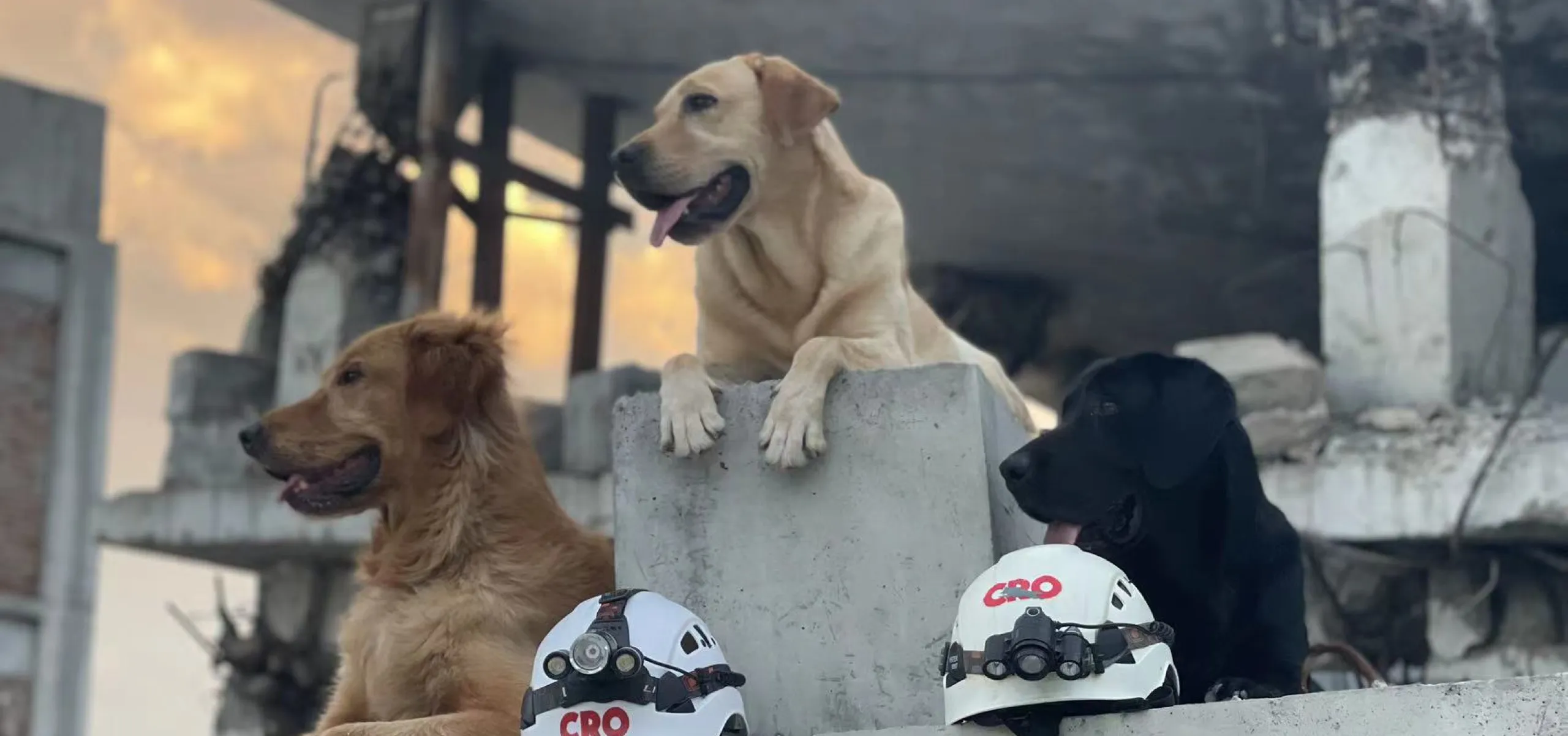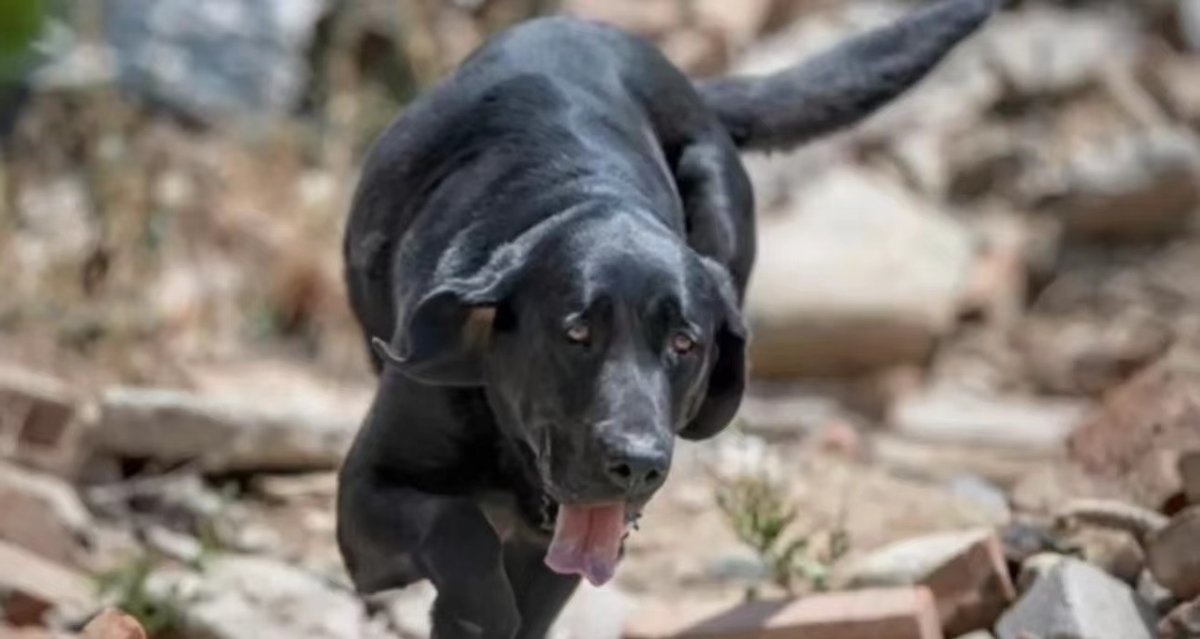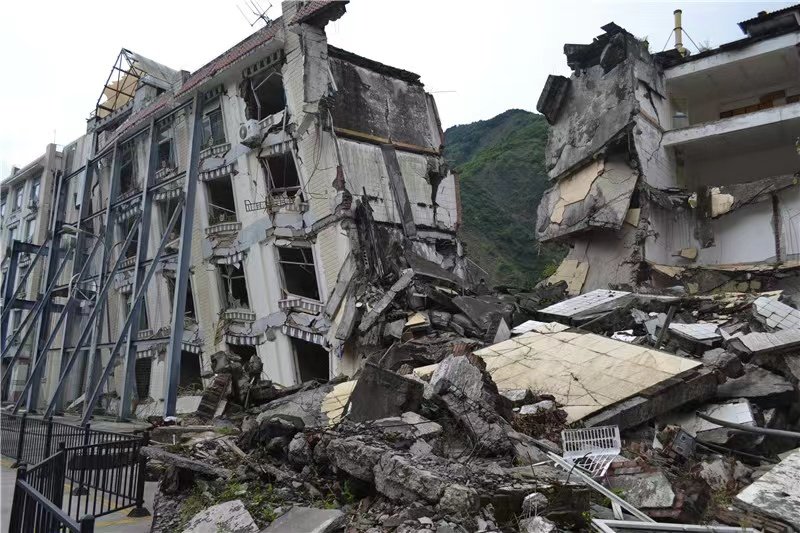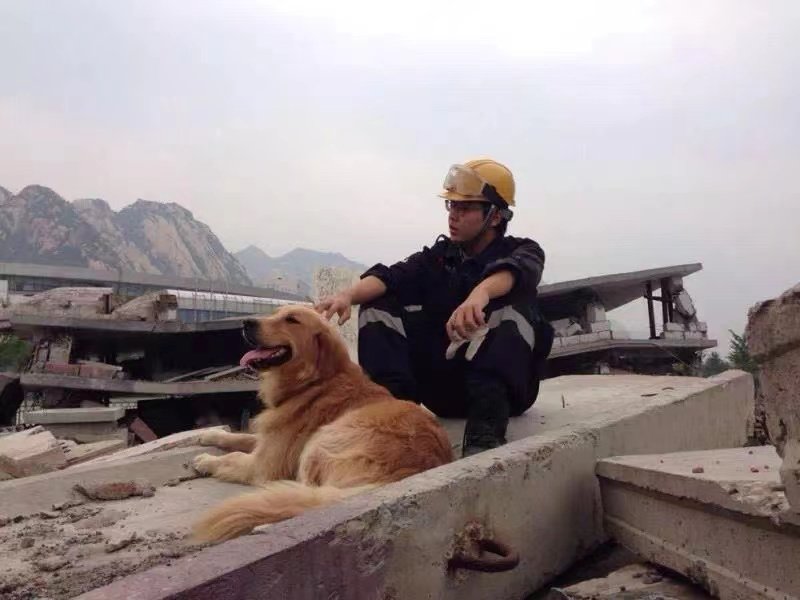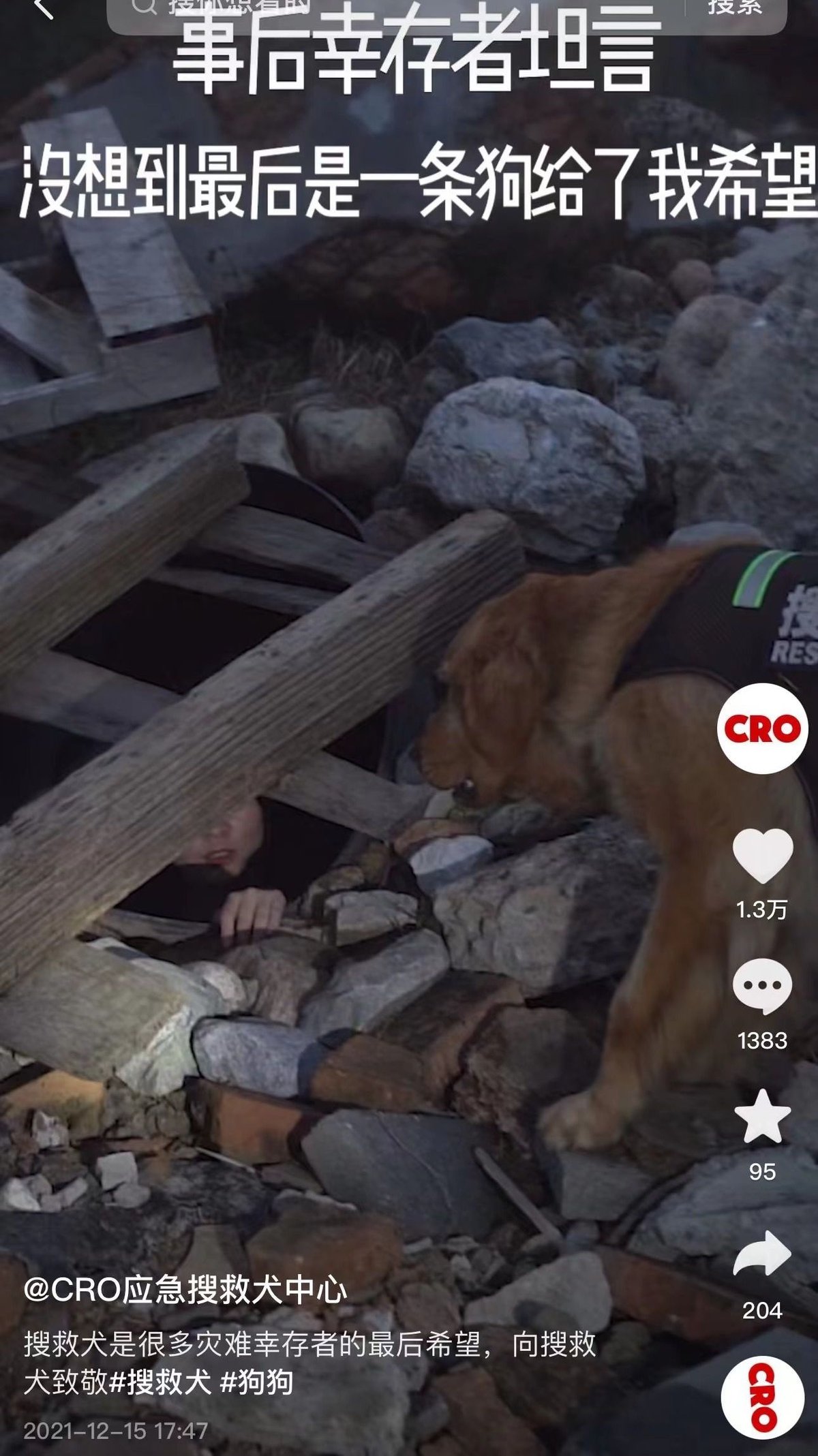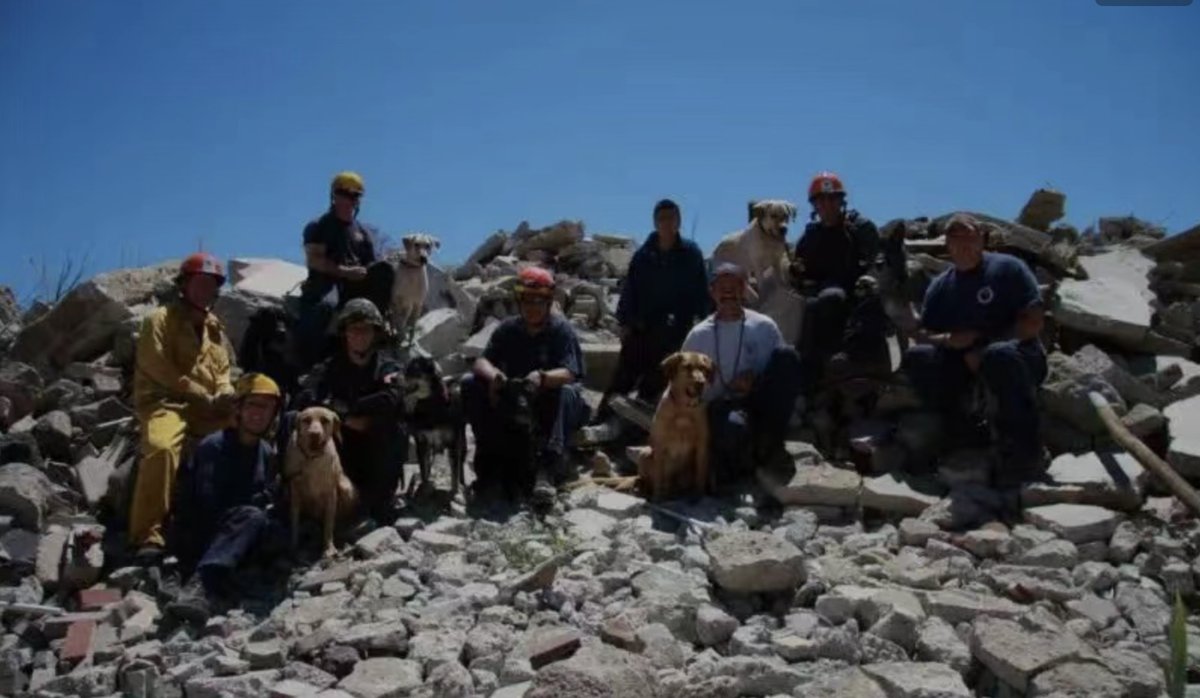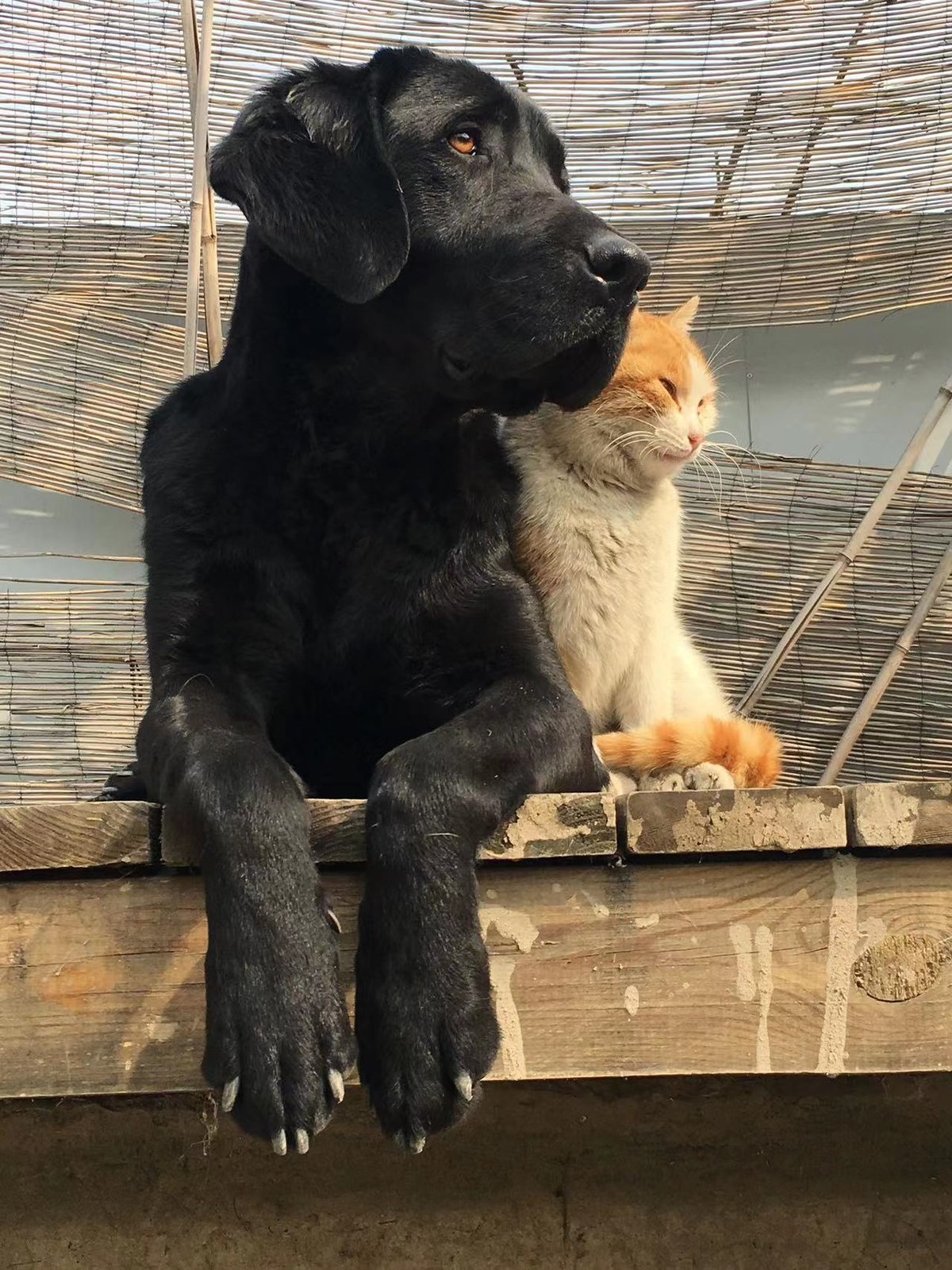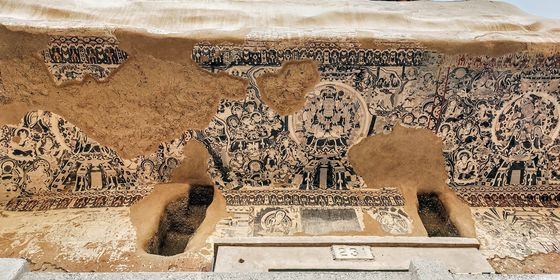Follow a father-son duo who trained some of China’s first internationally certified search-and-rescue dogs, and dream of having a dog for every city
Meet Zixie, a black Labrador searching for signs of human life at a training base simulating a landscape of ruins in the suburbs of Beijing.
Zixie is no ordinary pup. In fact, he is among the best of his kind. After beating his fellow Chinese contestants in an international competition, Zixie became China’s first search-and-rescue dog to reach his certification level under international standards.
Often, we get to hear all sorts of stories about search-and-rescue dogs and their role in large-scale natural disasters: such the Wenchuan Earthquake in 2008, after which a rescue dog managed to save 15 people from the debris. We’ve come to regard these dogs as true symbols of hope among the tragedy, as well as crucial resources for search-and-rescue efforts in the face of adversity. With this in mind, both China Fire and Rescue and the People’s Liberation Army (PLA) began training search-and-rescue dogs as early as 2001.
However, Zixie does not belong to any state organization, but rather to a private NGO where funds were very limited for a while. In fact, when the going got rough, Zixie lived just as frugally as his owner, Zhong Ming, the NGO founder himself.
In their training drills, Zhong can be found wearing a training uniform and lying on a dirty cement pipe in a simulated environment of ruins, waiting for the dog to come “rescue” him. He is a dark-skinned, weather-beaten middle-aged man who looked like the opposite of the artist and designer he once was over a decade ago. He probably couldn’t have imagined that a bold decision at that time in his life would lead him down a path of hardship, while simultaneously opening up new avenues for search-and-rescue dogs in China.
1
A bold decision
Zhong Ming: My name is Zhong Ming and I am from Beijing. I am also the director of an NGO known as the CRO Emergency Search-and-Rescue Dog Training Center (CRO 应急搜救犬中心), which is the exact handle under which you’ll find us on Douyin [Editor’s note: It has also been known under the names Canine CRO and Beijing Discovery Emergency Rescue Development Center]. Search-and-rescue dogs have been my life for the past 12 years, but I was once a complete stranger to this field. In fact, I used to work in art and design.
In 2010, when my son Bell—that’s his chosen English name—was 15 years old, I made a point of bringing him with me on a visit to the site of the Wenchuan Earthquake. Two years after the disaster, the area had yet to recover fully, and the sight of ruins in the distance shocked us as we hopped out of our car. It also prompted my son to ask, “How can they even rescue anyone who’s buried under the rubble?”
After discussing his question together, we came to see that this is where search-and-rescue dogs come in handy to save lives, guided by their sense of smell. That’s about as much as we could grasp about this whole notion of a “search-and-rescue dog” at that point.
After leaving Wenchuan, we actually started reading more about these dogs. There’s way more to them than just their sense of smell, because they also rely on their hearing and perception as additional tools to locate any survivors within an area of 2,000 square meters in only 20 minutes. A dog’s snout is equipped with an average of over 220 million olfactory receptors—3 million times those of humans [Editor’s note: other sources claim it’s 6 million times more powerful). These receptors can capture the subtle smell that the human body emits in the air. In addition, dogs’ hearing is about 16 times sharper than that of humans, and they also have extremely sensitive eyesight. These inherent traits make them really effective partners in disaster relief work.
We also learned that the situation of search-and-rescue dogs in China at the time had plenty of room for improvement. In the United States, a total of 199 search-and-rescue dogs were assigned to operations at the site of the September 11 attacks in 2001, covering a total area of 20,000 to 30,000 square meters. Barely a few dozen dogs were deployed to the site of the Wenchuan Earthquake, spanning over 100,000 square kilometers. In other words, China was at least a decade behind.
This is how I first felt an urge to devote myself to this field. Indeed, “an ignorant man is fearless”; I didn’t know what I was getting myself into. I was just eager to jump in and make a contribution.
2
Who can teach us to train a dog?
Once we were back in Beijing, Bell and I immediately bought a German Shepherd who we named Wukong. We had these grand plans to train him as a search-and-rescue dog all by ourselves.
However, soon enough we discovered that passion alone would only take us so far and that there was a dearth of truly useful, extensive information. Even online, barely the basics of real-life operations were covered. So-called “professional organizations” proved unable to provide a set of detailed training materials, and we weren’t the only ones seeking resources—some of the people who’d participated in the rescue efforts at the site of the Wenchuan Earthquake were also wanting to expand their knowledge. Everyone was facing the same issues; we didn’t have enough expertise in training dogs for search-and-rescue missions and teaching materials were seemingly nonexistent.
We tried to search for foreign websites and email addresses. Bell even wrote an email to them using his rudimentary English: “We are a rescue team in China. We want to learn about search-and-rescue dogs. Thank you.” Honestly though, we were definitely not a rescue team.
A week later, we were flooded with over a hundred emails in response to our call for help. We chose one of the most experienced organizations in the United States, the National Disaster Search Dog Foundation (SDF). Their email to us read: “We would be happy to offer you free-of-charge training if you came to our headquarters. Of course, our offer is contingent on your sincerity, and you’d have to cover your own flights and living expenses.”
We did the math and estimated that a 20-day training trip would amount to about 40,000 yuan. However, we wanted to see with our own eyes whether the US really could offer everything we imagined in terms of training search-and-rescue dogs, so we decided to carry on with the trip.
We recorded each and every training we attended while in the US, so that we could replay the videos repeatedly after we returned to China. It dawned on us that search-and-rescue dog-training was much more than just coaching a dog. What we were actually looking at was a modern system backed by plenty of technique and extensive knowledge.
As the saying goes, “Training dogs requires training people first.” In order to successfully complete a search-and-rescue mission, dog trainers need to cooperate closely with their dogs. They need to master all sorts of factors—terrains and landforms, search tactics, danger prediction, etc. None of this can be learned overnight. The process requires lots of training and real-life experience.
Of course, our experience abroad greatly benefited us. We’d learned a lot by way of training skills—helping dogs socialize better, stimulating them to go on searches and so on.
What’s more, we also learned that it’s impossible to train search-and-rescue dogs in an ordinary outdoor environment. We needed to find a training space that was large enough to simulate the site of a natural disaster, and this was rather costly. However, thanks to our time overseas, we learned what we needed to implement cutting-edge dog training technology across the country. We didn’t want to waste this advantage, so we decided to once again personally foot the costs to rent a large pit measuring over 10,000 square meters in the suburbs of Beijing.
We bought dozens of cement pipes and hired cranes and excavators in order to turn the plot into a landscape of undulating ruins. We were billed about 80,000 yuan, without any kind of sponsorship or even legal protection. When I told people we were going to start training rescue dogs, they said we were delusional.
Finally, we started our training in earnest, and pretty much right off the bat we realized Wukong was just not the right fit for a search-and-rescue profile. Because he wasn’t purebred, the traits of his species were already fairly diluted, something that was particularly apparent in the dog’s lower level of fitness. Wukong wasn’t really able to climb ruins and his personality was much too tame for the job.
There is a certain logical process that applies when you’re screening dogs for this purpose. You must pick a sporty dog that is just the right size and won’t turn out to be aggressive. You want to look for species such as Labradors, golden retrievers, border collies, collies, and Malinois.
Enter Heaven, a small golden retriever who we’d found abandoned in the streets.
At the beginning of our training, we would hide in the ruins and call for the dog. “Heaven! Heaven!” When she ran over, we rewarded her with some yummy treats. At first, we only let Heaven interact with my son or myself before allowing her to come into contact with all sorts of people—men and women, young and old. Heaven took everything as a happy game where she rejoiced every time she found a “survivor.”
That dog really loved searching. As soon as she trotted into the field, Heaven best resembled a kid about to play ball. Sometimes, to our great distress, she would fall flat on her face. However, she never failed to get up with a little shake of her bottom to go back to looking. Heaven was only unhappy when she couldn’t find her designated target.
Heaven’s meteoric rise gave us a sense of accomplishment; all the time and money we had spent to acquire our knowledge had paid off. So, my son Bell and I started to share some of our learning experiences and training videos from our time abroad on the internet. Plenty of people from all over China contacted us in response, wanting to get in touch and learn about search-and-rescue dogs. Eventually, we made four or five friends who ended up joining us.
This is how our team came into being. This is also how our rented training space became much more lively, giving us all a boost of motivation. For a while, things were going pretty smoothly.
It was also at this time that Heaven scored us our first chance to set out on a real life mission after about a year of training.
3
Our first mission: the Ya’an Earthquake
In April 2013, in the aftermath of the Ya’an Earthquake in Sichuan, we took Heaven to experience our first rescue mission.
On departure at Beijing Capital Airport, our team uniforms caught the attention of people who would ask us what kind of help we needed. A frequently asked question was “Who will reimburse your expenses?” When we replied that we would be covering those ourselves, these strangers were keen on reimbursing us for our travel costs. This was really touching.
We boarded our flight and Heaven got checked into the cargo hold. We arrived in Sichuan together after a four-hour flight.
When we made it to Ya’an, we had to start walking as there was a long section of the road that had been closed to traffic. Locals and some soldiers deployed in the area would ask us whether we needed water and food. In fact, some didn’t even ask and just loaded us with steamed buns and big Chinese pancakes. Though the journey was hard, we also felt a great deal of warmth.
However, when we eventually got to the disaster site, I found Heaven was limping. Our dog wasn’t her usual energetic, cheerful self. Instead, Heaven was refusing food and drink and trotting loosely, with none of her former gait. It was only later that I learned that the cargo hold in which Heaven had traveled was not soundproof. This meant that the noise of the plane’s engine was like a high-pitched loudspeaker, constantly screeching in Heaven’s ears for four hours. Heaven was so affected by this ordeal that she was no longer capable of taking part in any search operation.
Here you have yet another situation that they don’t cover in the standard training materials. In other countries, search-and-rescue teams always travel together in the exact same space—people and dogs alike.
Back to our experience in Ya’an, though, there was more in store for us to learn. We realized that the site of the disaster was still really chaotic, and the atmosphere overall was very tense. Safety just wasn’t guaranteed, wherever you stood. We were supposed to have been assigned some headquarters, except nobody could find them. We were told that there was an emergency in a village, so we rushed there, only to find that what they actually needed was medical assistance. In situations like this, we’d have loved to contribute, but we simply didn’t know how.
The next day, everyone was exhausted as we arrived at a nearly entirely collapsed bungalow with some reporters on duty. It was right about then that we finally acknowledged that our training was still insufficient to face a real-life disaster scene.
Our training ground had no buildings—blame that on funding. At any disaster site, you’re likely to find all sorts of collapsed buildings everywhere, piled up in strange shapes. Each rescue area is sure to present you with challenges you’ve never trained for and are therefore unfamiliar with, and there will be plenty of accidents. For example, a dog may assume that there is a small, short wall in front of their eyes and will try to jump over it, only to fall in a three-meter-deep pit. And that’s without taking into account the steel debris all over the place, which can easily injure dogs.
Heaven hadn’t quite recovered yet when we took her on a search mission. We got into a house and I found that the wall next to it was actually fairly dangerous, as it could fall down at any time. I stood next to Heaven to protect her as I checked the condition of the wall. Once we confirmed that there were no survivors, I quickly called Heaven back to leave for the next area. This search lasted about two hours.
In the end, our inability to help at Ya’an was a hard pill to swallow. Heaven’s poor condition after the flight, the tension and chaotic management at the disaster site, our own shortcomings in training, and the stark contrast with the reality of a real-life scene...all we could do in the end was help to mark out those areas in need of rescue efforts. We did not really find any survivors nor victims.
However, the whole experience did inspire us a lot. For starters, we acknowledged that our training was nowhere near difficult nor comprehensive enough. Once we made it back to Beijing, we started planning our move to a more appropriate training space that was as close to a real disaster site as possible.
We also gave some thought to improving safety protocols for rescue dogs on the job, adding a whole section to our training focused on blocking out external interference. Namely, we trained our dogs to withstand noises such as firecrackers, loudspeakers, and gunshots, so that they may remain in the best possible condition in every scenario—from boarding a flight to facing a tense search and rescue mission.
And then, just as we’d started to neatly prepare for the future, an unforeseen event frustrated all our plans.
4
“Ruins are prohibited here!”
Just one week after the Ya’an Earthquake, we were served a notification telling us to clear away the landscape of ruins we had recreated in our rented plot. This effectively meant demolishing our site.
Now, we were indeed using this space for quite the specific purpose, and it was indeed the local government’s prerogative to order demolition. Law and reason were on their side. The truth is, you won’t find anyone renting such a large plot just to fill it with ruins, like I did. People just build apartment blocks for profit, and here I was with my dog-training endeavor. I stood no chance.
On the day set for demolition, we probably had over 100 policemen at the site. The landlord gave us three days to remove all our own belongings from the site, but of course, I wasn’t going to take anything with me, so everything got completely torn down in the space of those three days.
For the next six months, we found ourselves in really low spirits. Should we even be doing this at all? We were paying for everything out of our own pockets—studying abroad, building ruins, even the actual search-and-rescue assignments. However much we felt this obligation to save our fellow man, the truth is we did not have to.
However, our hearts had already become fixated on this whole thing, and I’m nothing if not stubborn. Defeat is not a word in my vocabulary. So, we decided to try again with a different approach. We had about 300,000 to 400,000 yuan left by that point. Instead of building another ruin, we decided to use that money to study.
To improve my knowledge of search-and-rescue dogs. I went to Japan three times. I also went to Taiwan once. I met search-and-rescue volunteers from various countries, and tried to learn from them. I accompanied them into ditches, into ruins, and tried to learn whatever I could.
This break lasted for two years, and I never stopped seeking new opportunities to learn during that time, until one day a new door finally opened. We were recommended by someone to the International Search-and-Rescue Dog Organization (IRO), the worldwide umbrella organization for search-and-rescue dog work and partner of the UNO.
China’s investment in the field has been stagnant due to a series of factors. However, going through an internationally certified system meant that we could carry out batch training according to a set of standardized procedures. Then there was an eventual examination that was the final, compulsory step for any dog to be considered ready for search-and-rescue.
Our situation up to that moment, in fact, had quite a bit to do with the lack of standardized assessments we’d experienced. If you search for search-and-rescue dogs on social media, you might find videos of dogs that have been trained to bite people in order to protect their owners, but search-and-rescue dogs must not be aggressive. If a dog like that is deployed to a disaster site, it could actually put survivors at risk.
However, in order to join an international organization, we had to become a legal entity. Therefore, we applied for the status of an emergency-focused NGO with the Civil Affairs Bureau. Once the application was successful, we mailed proof of our newly acquired status to the IRO.
A week later, I got a letter back saying, “Welcome to the International Search-and-Rescue Dog Organization family.”
This is how we successfully joined their ranks in October 2015. From that moment on, not only was our team finally protected by law; we were also finally able to introduce an international, comprehensive scheme for the certification of search-and-rescue dogs into China.
What’s more, my son Bell, already a college student, translated a booklet known as the “International Trial Rules for Search-and-Rescue Dog Tests” into Chinese. It was compiled jointly by the IRO and the International Canine Federation. He published it at his own expense and introduced it to a series of professional search-and-rescue dog training organizations and fans nationwide. The document is a detailed record of all the boxes that need to be checked for a dog to become involved with search-and-rescue, including a set of certification standards featuring a total of 13 ability indicators such as traversing, search, and concentration. These standards finally enabled the training of search-and-rescue dogs in China to enter a new, more standardized and scientific chapter.
This event greatly motivated our team, and so once again we rented a training venue in the suburbs of Beijing to rebuild our landscape of ruins. We’ve been based there ever since, and we’ve also had two new key members join our team—Zixie, a Labrador retriever, and Bart, a golden retriever. And so we got down to work again, revisiting training methodology in our brand new space.
5
Zixie and Bart
I was driving to Sichuan when I saw Zixie, a black Labrador, on the side of the road.
Zixie was part of a big litter of puppies from a breeder. Though not the quickest among his siblings when I first approached them, he was the only one out of eight pups to grunt at me in a friendly way. I thought he displayed suitable traits to become a search-and-rescue dog, so I bought him.
Once I got to know him, I found Zixie to be confident and brave. He’ll wail every time we exclude him from a searching exercise. And, whenever he does go out into the training field, he will scold other dogs and show off his searching skills.
Later, I returned to Beijing and bought Bart, our golden retriever. Bart’s original owner was a fish seller who went bankrupt and had to return home. I got the dog for 2,000 yuan in a bazaar.
Bart is an extremely smart dog—quick to learn how to take advantage of every situation in order to please his master and put the blame on others. Depending on how you manage this all, it can either be a blessing or a curse. For starters, Bart is as clever as he is playful. I handle him like you would a child with homework: “You can play once you’re done with your training! Come on! Good boy!”
These dogs are like my own children to me, and in every rescue operation, I feel like a general going into battle with his own son.
Our base is in the countryside, where you often have folks coming to pick up dogs and chickens from the streets and loudspeakers shrieking messages like: “We take dogs! We buy big dogs!” Whenever this happens, Zixie will drop whatever he’s doing and start whimpering. But, I always hug him and reassure him: “Don’t worry, your father will not sell you. You are my son, how could I possibly sell my children?” And he understands and will give me this look of deep gratitude.
When I first got Zixie and Bart, our family still had money and I had been taking my training skills to the next level, so the pair improved by leaps and bounds and for a while, we were on track.
6
“Large dogs prohibited”
Eventually, though, I did run out of money.
At our most difficult period, all we had to eat every day was one big steamed cornmeal bun each. We ate so much cornmeal that even our poop began to resemble it. But even in these trying times, Zixie and Bart rushed forward during every training session.
Misery breeds company, though. The government prohibited raising large dogs in the city. Even though I am from Beijing, my dogs can’t enter the city.
Once, I took Zixie to the vet and he stayed overnight with me in the city. The neighborhood committee chose this moment to come over and complain, “You’re not allowed to raise dogs like that in the city!” I replied, “Zixie is a search-and-rescue dog!” But they didn’t care one bit.
What’s more, you can only have one dog per registered permanent residence permit. When we applied for a dog license, we had to ask some other folks without dogs at home to help. Long story short, Zixie isn’t registered in my name. We had to use connections in the village to get him registered.
We felt really aggrieved. We’d spent nearly 1 million yuan at that point, and that’s no small change for an ordinary family. Still, we felt it was worth every penny, every hardship we’d gone through too.
7
A star is born
That year, we invited a group of experts from abroad to attend the international search-and-rescue dog competition. On the day of the event, the temperature hit 37 degrees Celsius—the concrete floor felt hot beneath our feet. Where plenty of people gave up, there was a black Labrador that just wouldn’t quit.
That was Zixie, and he ended up ranking first in China and eventually sweeping the podium in the international qualification rankings. He was now ranked in the B level. This meant that he was now qualified to serve in international rescue operations. In the event of a major disaster, I could bring Zixie and Bart with me and stand in charge of search operations in a large area.
Then, a man who’d drunk too much went missing in the winter of 2018. The police came to request our help at 1 or 2 in the morning. At 5, Zixie and I drove from Beijing to Binzhou in Shandong province. Four hours later, we arrived at the scene of the incident—it was already 9 in the morning. There was a pond choked with reeds, and the water had frozen due to the drop in temperature, which had hit at least 10 degrees below zero.
During the rescue, Zixie and I managed to fall together into a hole in the ice. We were a little flustered in that moment, and glanced at each other as if wondering the next step to take. Eventually, I managed to prop Zixie up and I navigated the ice to climb my way back onto the shore myself. Both of us were covered in ice.
But, some 40 or 50 meters away from the ice hole, Zixie started circling around. I figured there was something there.
Here’s the thing, at any given rescue scene, the search and rescue parts are separate tasks performed by separate teams. The rescue team we’d come to support had already been at work for hours before we arrived, and so even if they actually found the man, more likely than not he was bound to have passed already. So, his family gave consent to stop the rescue operations at the time.
Come spring in March, the ice thawed and the remains of that man floated right up from the spot that Zixie had located. This proved his sharp skills, and I was happy to reward him accordingly with an extra chicken thigh.
In most cases, you are bound to come out with corpses from the scene of a disaster. As regrettable as it is, there’s no way around it. Far too often, there are no qualified rescue dogs near the site of the incident, and so by the time they are deployed they’ve already missed the window for the most successful rescue.
There really are far too few such dogs for a country as vast and populated as China is. According to standards in European and developed countries, there should be one search-and-rescue dog like Zixie for every 400,000 people. With approximately 1.4 billion people in China, in theory we would need 4,000 more dogs. But so far, only 12 dogs have reached Zixie’s level, and one of them has passed away already.
8
A dog for every city
Eventually, after countless search-and-rescue assignments in which we did not get there in time to save the victims’ lives, we came to a very firm conclusion—the strength of a single team is far from enough. In addition, we also came to realize that many of the teams that train these dogs just want to show off at contests. For those folks, it doesn’t really matter whether they can save lives or not.
We decided to adjust our focus and compile our knowledge into courses in order to increase the number of dogs that can truly be called search-and-rescue dogs in China, so that rescue teams in more cities may have these excellent allies. Using platforms like Douyin, we have tried to attract more teams or enthusiasts who are keen to train search-and-rescue dogs, and teach them the most cutting-edge training methods.
We feel that our efforts over time will have been truly worthwhile if we can reach a point where every city in China has an excellent search-and-rescue dog like Zixie, capable of rescuing someone’s child, parent, or sibling—anytime, anywhere.
In addition, we are also trying to raise funds for our search-and-rescue dog charity project through the ByteDance charity platform. We are really grateful that our public welfare projects have received support, understanding, and sponsorship from many people, helping us relieve some of the financial pressure in turn.
So far, we’ve gone on two nationwide tours giving public lectures. In the first year of the pandemic, my son and I logged over 10,000 kilometers at the wheel. As long as there is someone interested in learning about search-and-rescue dogs—whether they are firefighters, civilian rescue teams, or simply enthusiasts—we’ll include them in our itinerary and reach out.
Though the format we’ve chosen for our lectures may admittedly be a bit boring, promoting them through Douyin will double the effect they have on the audience, as plenty of people actually find us through this platform when they’re first interested in learning more about search-and-rescue dogs: not just ordinary people, but many professional teams too. In fact, we’ve had more than a few people knocking on our door after getting to know us through Douyin, wanting to learn how to train these dogs themselves.
Platforms such as Douyin and ByteDance have not only introduced us to a broad audience—they’ve also played a big part in spreading professional knowledge on the matter.
We have both offline and online courses, and with our continuous promotion, we have enrolled some 40,000 students over the years. Some 300 to 400 people have actually come to our base to train with their dogs and sit the certification exams, often paying out of their own pocket. Many rescue teams came to be as a result, and plenty have gone on to save lives in all sorts of emergencies.
Here, one team from Jiangsu province comes to mind. They’d trained for some three or four months, and then one night the guy running the team called to tell me that they’d recently taken part in an assignment where a large area of scaffolding on a construction site had collapsed. Thanks to their fast response, all in all it took them about an hour to determine the location of the two workers who had been trapped under the rubble. Take search-and-rescue dogs out of the picture, and it could have taken a full week to clear the site.
9
On track at last
To date, our organization has spent about 3 million yuan since we started—and that’s being conservative with our calculations. At the early, experimental stage, the cost of training a search-and-rescue dog can reach 1 million yuan. Nowadays, with our relatively mature techniques and system, we’ve managed to curb training costs to some 200,000 yuan.
So, it goes without saying that the loss of every dog hurts. When selecting a dog as a candidate for training, you have to consider not just its personality, but its health. Yet you can’t completely avoid diseases.
Both Wukong and Heaven died when they were 6 years old. Wukong suffered from a tumor, while Heaven had internal organ issues. We buried them both in the training ground.
Luckily, we still have five dogs with us—Zixie and Bart, both at the B level, and Ya’an, Daqiao, and Wolong, our Level A trio. What’s more, the days of stuffing ourselves with steamed cornmeal buns are long behind us. We’ve gained quite a lot of sponsorships and support, and we’re at last on track after more than a decade of efforts.
These dogs are simple creatures, really. As long as you let them go on a search, they’ll immediately spring into action. They couldn’t care less about certifications, and they will hunt anyone down—fugitives, homeless folks, students. They’ll be satisfied as long as they find their target; as long as they find a thread of life.
I used to think I was the king of the world in my past life as a painter and designer. I was really full of myself, and then I became a search-and-rescue dog trainer and things were much more difficult. But, truth be told, Zixie has taught me a ton over the years, and I guess I could boil it down to two key values—faith and responsibility. When you find yourself blessed with a good life, you should pay it forward to those around you.
Photographs provided by Zhong Ming (钟鸣)
Produced by Zhao Zhenyi (赵臻怡)





